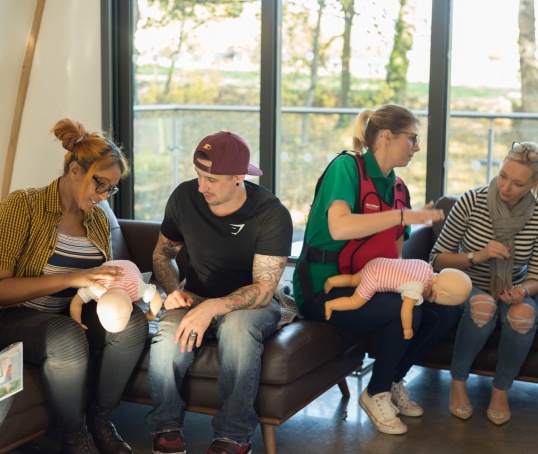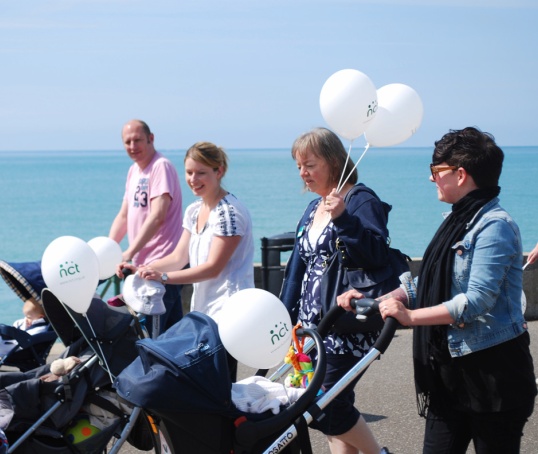Does it have a best before date? And how exactly do you get it out? We have the answers to your most common questions about expressing breast milk.
What does ‘expressing milk’ mean?
Expressing milk means the same thing as pumping milk. It’s a way of taking milk from the breasts without baby needing to breastfeed directly (NHS Choices, 2014). You can do this using your hands, a manual pump or an electric breast pump.
Using expressed milk can be handy for women for many different reasons. Some people may do it because they have babies who can’t feed. Some because they might want to allow a partner or other family members to get involved in feeding. Others find it helpful in the early days for comfort. For example, if their baby is not feeding effectively, or has had a longer gap between feeds leaving them feeling uncomfortably full or engorged.
Do I have to express milk if I’m breastfeeding?
Not at all. Only do it if it’s something that works for you and your baby. If you do decide to express, it may help to wait until you and your baby are in the habit of breastfeeding. Some women find it helpful to try around three to six weeks in, as they've usually resolved any early day challenges by then. There is no evidence to suggest there's a 'best' time to see whether your baby takes a bottle.
How long should I express for?
Get comfortable and express your milk for as long as it is flowing well rather than letting time guide you. This will vary between women: for some five minutes on one breast will be enough while others will find it helpful to spend 15/20 minutes. It's usually more efficient to pump both breasts at the same time. Some mums also find it helpful expressing on one breast while feeding their baby from the other. Babies are very good at encouraging the release of oxytocin, the hormone associated with the milk ejection reflex.
Do I really need to sterilise everything I use to express milk?
The guidance varies a lot, which is really confusing. What everyone agrees on is that starting with clean hands really matters. The NHS says it’s important that you clean and sterilise any containers or parts that your milk touches, like pump flanges, bottles, cups or spoons after every use, until the child is at least 12 months old (NHS Choices, 2016).
The Academy of Breastfeeding Medicine suggests sterilising is not necessary but that everything should be thoroughly cleaned in hot soapy water, rinsed well and dried (air or paper towels).
Does expressed breast milk need warming up?
Babies don’t need their milk warm but some prefer it at body temperature. The safest way is to stand it in a jug of warm water.
Warm the milk just enough to take the chill off and shake out a few drops onto your wrist to test. Never heat milk in a microwave as it can lead to uneven heating and burn a baby’s mouth (American Academy of Pediatrics, 2011; NICE, 2014).
How much milk will I need for one feed?
Babies differ so much and while young babies can only take around a few millilitres at a time, older babies will of course take more. Your baby’s appetite may be bigger at different times of day, and from day to day, just like yours.
If you still want a rule of thumb, leave around 90-120ml for a feed for a baby over a month old. Less for a younger baby. Try that until you get to know your baby’s habits. Some babies will take very little while they are separated and catch up when they're reunited with their mum. Remember taking milk from a bottle is a skill your baby has to learn.
How do I store expressed milk in the fridge?
Store milk in sterilised containers or in plastic bags made specifically for storing milk. Write on them the date and use up the oldest first (NICE, 2014).
You can store freshly-expressed milk for up to five days in the main part of a fridge, at 4°C or lower (NICE, 2014). If you’re not sure of the temperature or if it’s higher than that, use it within three days.
Go for the fridge as your first option as freezing breast milk alters some of its biologically active components (Piela et al, 2017).
If you need it on the go, you can store your refrigerated breast milk for 24 hours in a cool bag or box with ice packs in it.
What about storing expressing milk at room temperature?
The guidelines for storage of expressed milk at room temperature (between 16-25°C) vary greatly, as studies suggest different optimal times (Liebert, 2017).
Warmer temperatures can allow bacteria to grow more quickly. However, around six hours would seem to be a reasonable time for milk collected hygienically (with a sterilised pump and really clean hands).
If the breastmilk has gone off, it will smell unusual. Don't worry if it looks a little weird. Separation is very normal, with the fat rising to the top. Just give the bottle a good shake before offering it your baby.
How do I store expressed milk in the freezer?
In the freezer compartment of a fridge, you can store expressed breast milk for two weeks. If you store your breastmilk in a stand-alone freezer, it’ll last up to six months at as long as it’s at -18°C or lower (NICE, 2014).
It's easier to write the date on the bag before it's full of milk, and do leave some space at the top of the bag as the milk will expand as it freezes.
How do I thaw frozen breast milk?
You can thaw frozen milk by defrosting it in the fridge (NICE, 2014). You can also stand it in a container of warm water (not hot or boiling). Never use a microwave to warm or defrost your milk (NICE, 2014).
Once milk is thawed it can separate so give it a swirl or gentle shake. There are mixed opinions about how long you can keep thawed breast milk. Some say to use it straight away and throw away any that’s left, others suggest a few hours at room temperature is fine (ABM 2017). If it smells sour throw it out.
Is it normal for expressing breast milk to be painful?
Expressing milk shouldn’t be painful. If you’re finding it difficult, call our support line on 0300 330 0700 to speak to a breastfeeding counsellor or talk to your midwife (NHS Choices, 2017). There could be many reasons like the suction being too strong, or the nipple rubbing against the flange.
Is there anything else I need to know about expressing breast milk?
Yes, the more relaxed you are the easier it will be. The hormone oxytocin is released when you’re feeling happy and relaxed, and that’s what causes your milk to be let down. Having your baby or a picture of your baby nearby or smelling their clothes can help.
This page was last reviewed in March 2019
Further information
We support all parents, however they feed their baby. If you have questions, concerns or need support, you can speak to a breastfeeding counsellor by calling our helpline on 0300 330 0700, whether you are exclusively breastfeeding or using formula milk. Breastfeeding counsellors have had extensive training, will listen without judging or criticising and will offer relevant information and suggestions. You can also find more useful articles here.
You might find attending one of our NCT New Baby courses helpful as they give you the opportunity to explore different approaches to important parenting issues with a qualified group leader and other new parents in your area.
Make friends with other parents-to-be and new parents in your local area for support and friendship by seeing what NCT activities are happening nearby.
healthtalk.org has a comprehensive library of face-to-face interviews where parents share their experiences about breastfeeding, birth, parenting and many other issues.
Best Beginnings has video clips from the 'Bump to Breastfeeding' DVD.
American Academy of Pediatrics. (2011) Practical bottle feeding tips. Available from: https://www.healthychildren.org/English/ages-stages/baby/feeding-nutrition/Pages/Practical-Bottle-Feeding-Tips.aspx [Accessed 1st October 2017].
NHS Choices. (2016) Sterilising bottles. Available from: https://www.nhs.uk/conditions/pregnancy-and-baby/sterilising-bottles/ [Accessed 1st October 2017].
NHS Choices. (2017) Benefits of breastfeeding. Available from: https://www.nhs.uk/conditions/pregnancy-and-baby/benefits-breastfeeding/ [Accessed 1st October 2017].
NICE. (2014) Breastfeeding recommendations. Available from: https://www.nice.org.uk/guidance/PH11/chapter/4-Recommendations#breastfeeding-3 [Accessed 1st October 2017].
Peila C, Coscia A, Bertino E, Li Volti G, Galvano F, Barbagallo I, Gazzolo D (2017) Human milk adrenomedullin is unstable during cold storage at 4°C. Breastfeed Med. 12(9):561-565. doi: 10.1089/bfm.2017.0072. Available from https://www.ncbi.nlm.nih.gov/pubmed/28956619 [Accessed 1st October 2017].
UNICEF. (2015) Guide to bottle feeding. Available from: https://www.unicef.org.uk/babyfriendly/wp-content/uploads/sites/2/2008/… [Accessed 1st October 2017].
University Hospital Southampton NHS Trust. (2014) Syringe and cup feeding your baby. Available from: http://www.uhs.nhs.uk/Media/Controlleddocuments/Patientinformation/Pregnancyandbirth/Syringe-and-cup-feeding-your-baby-patient-information.pdf [Accessed 1st October 2017].
Further reading
Breastfeeding Network. (2009) Expressing and storing breastmilk. Available from: https://www.breastfeedingnetwork.org.uk/wp-content/pdfs/BFNExpressing_a… [Accessed 1st October 2017].
Healthy Children. (2011) Practical bottle feeding tips. Available from: https://www.healthychildren.org/English/ages-stages/baby/feeding-nutrition/Pages/Practical-Bottle-Feeding-Tips.aspx [Accessed 1st October 2017].
NHS Choices. (2009) Breast milk ingredients and sleep. Available from: http://www.nhs.uk/news/2009/10October/Pages/Breast-milk-ingredients-and… [Accessed 1st October 2017].
NHS Choices. (2016) Expressing and storing breast milk. Available from: https://www.nhs.uk/conditions/pregnancy-and-baby/expressing-storing-bre… [Accessed 1st October 2017].
NHS Choices. (2018) How to bottle feed your baby. Available from: https://www.nhs.uk/conditions/pregnancy-and-baby/bottle-feeding-advice/#how-to-bottle-feed-your-baby [Accessed 1st October 2017].
Science News. (2015) Backwash from nursing babies may trigger infection fighters. Available from: https://www.sciencenews.org/blog/growth-curve/backwash-nursing-babies-may-trigger-infection-fighters [Accessed 1st October 2017].
UNICEF. (2018) Skin to skin contact. Available from: https://www.unicef.org.uk/babyfriendly/baby-friendly-resources/guidance-for-health-professionals/implementing-the-baby-friendly-standards/further-guidance-on-implementing-the-standards/skin-to-skin-contact/ [Accessed 1st October 2017].






